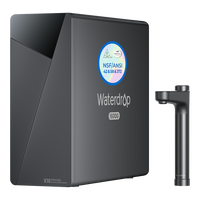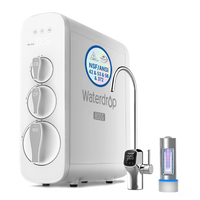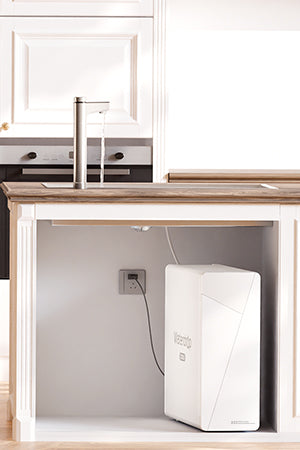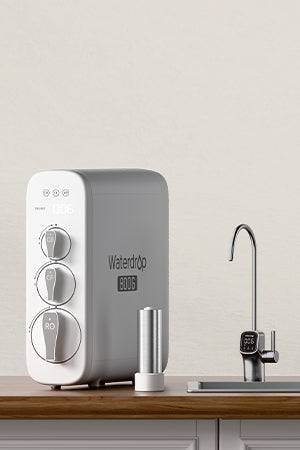The increasing demand for
reverse osmosis
water systems is not surprising,
considering how advanced this water filtration technology is. Here is a blog that we wrote before that explains
how powerful the reverse osmosis is:
How Does a Reverse Osmosis
Filter
System Work? RO system efficiently
removes contaminants, providing high-water, clean, and healthy water for drinking and cooking. However, it also
produces wastewater – a major concern for users. Traditional reverse osmosis systems produce up to four cups of
wastewater for every cup of filtered water.
How is this possible?
Reverse Osmosis Waste Water
A reverse osmosis system uses more feed water and produces less filtered water.
Let’s discuss the
working principle of reverse
osmosis to establish
this fact.
Reverse osmosis involves forcing water through multiple extremely-fined membranes,
thanks to the composition of water. The RO membrane
prevents harmful
substances like heavy metals, sediments,
viruses, bacteria, and others from passing.
The water that goes through the RO membrane contains no contaminant. However, the
concentrated water on the other side of the membrane is the "wastewater," containing all the removed impurities.
It is eventually flushed out.
How much wastewater does the reverse osmosis system produce?
This depends on the
water pressure of the
system. The traditional reverse osmosis
water filter systems use up about four gallons of wastewater for every gallon of filtered water produced. This
is due to the presence of a water tank and the resulting low pressure of 7-8 psi. The ideal pressure is within
35-40 psi.
However, with advanced technologies emerging, the reverse osmosis filtration
process is now more efficient. The
modern reverse osmosis
systems do
not have tanks. Instead, they are equipped
with powerful internal pumps for increasing the water pressure.
You can only get 75 gallons of pure water daily out of a traditional RO system
because of the low pressure. In contrast, you can get up to 800 gallons of filtered water out of the advanced
tankless models. The latter is also more efficient, with a waste ratio of 1:1 or 2:1, translating to 2 gallons
of pure water for every gallon of wastewater.
The Waterdrop G2P600 is popular among other reverse osmosis systems because of its
600 GDP large water capacity. It uses up only a cup of wastewater for every two cups of pure water it dispenses.
Unlike the traditional RO water purifiers with tanks, this model is tankless and can help you save up to 600%
more water.
The condition of the filter also contributes considerably to the overall efficiency
of the system. If the valves are worn out, your system will most likely produce more wastewater. A consistent
maintenance culture can solve this problem.
Reducing Waste Water
The simple solution is to improve the drain ratio from the two aspects identified
above.
Maintain an adequate water pressure level
The reverse osmosis system will produce more wastewater at lower water pressure.
Therefore, running at a household water pressure lower than the ideal 35-40 psi range can be counterproductive.
If your pressure valve is okay and you are still running at low pressure, kindly check with your local water
authority for possible pressure issues.
Maintain your water filter properly
The only way to get the best out of reverse osmosis filters is to check on them
regularly. Most reverse osmosis water filter systems come with a five-stage filter cartridge setup. The filter
in each stage is different and made specifically for a group of contaminants. Thus, the service life of each
filter is different. The average service life of a reverse osmosis filter is between a year and two years, but
it may be shorter or longer.
It is best to replace your filter once it expires. This, alongside other
maintenance activities, can ensure you get the best filtration results and higher efficiency.
Learn more about how to maintain your water filter through
Tips for
Maintaining
Your Home Water Filtration System.
Getting The Best Out Of Wastewater
Wastewater from reverse osmosis water is not suitable for drinking or cooking.
However, you can store it in a large tank outdoors and recycle it for any of the following applications:
Washing of cars
Washing a car requires about 14-75 liters of water per session. The accumulated
wastewater from your reverse osmosis system can easily meet this need.
Household activities
Mopping the floor is another good use of wastewater. Again, the effect is similar
to using tap water – using wastewater even reduces possible salt deposits and stains.
Flushing of toilets
While you cannot use the wastewater for bathing or laundry because of the hardness
of the water, you can use it to flush your toilets after use. It is also suitable for cleaning up your bathroom
fixtures and faucets.
We have a detailed blog that introduces several ways to reuse your RO waste water,
check this out:
Is the
"Wastewater" Produced by the RO System Really
Wasteful?






































































